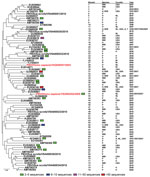Volume 18, Number 9—September 2012
Letter
Picobirnaviruses in the Human Respiratory Tract
To the Editor: Picobirnaviruses (family Picobirnaviridae) are nonenveloped, double-stranded RNA viruses of vertebrates with a bisegmented genome. Segment 1 (2.2–2.7 kb) encodes the capsid protein, and segment 2 (1.2–1.9 kb) encodes the RNA-dependent RNA polymerase. On the basis of sequence diversity in segment 2, picobirnaviruses are classified into 2 genogroups (1–4). Picobirnaviruses have been detected in fecal samples from humans with and without gastroenteritis; in patients co-infected with known enteric pathogens, including rotaviruses, caliciviruses, and astroviruses (1,4); and in a wide range of animals, such as pigs, calves, dogs, monkeys, and snakes. The pathogenicity of picobirnaviruses largely remains to be determined, but studies in immunocompromised persons suggest that picobirnaviruses may be opportunistic enteric pathogens (5,6).
Recently, we identified picobirnaviruses in the respiratory tract of pigs in Asia, and this identification expanded the knowledge on the tropism and host range of picobirnaviruses (7). No respiratory or other clinical signs were observed in these pigs at the time of sampling, making it unclear whether picobirnaviruses are indeed respiratory pathogens (7). To determine whether picobirnaviruses could also be present in the human respiratory tract, we performed a diagnostic genogroup I picobirnavirus PCR, with degenerated primers, that targeted the RNA-dependent RNA polymerase coding region (1,4,8) on 309 bronchoalveolar lavage specimens collected from 309 patients with respiratory disease of unknown origin in the Netherlands during 2003–2006. (All study procedures were performed in compliance with relevant laws and institutional guidelines and in accordance with the Declaration of Helsinki.)
Samples from 3 patients were confirmed by sequencing to be positive for genogroup I picobirnaviruses. To determine genetic relationships between human genogroup I picobirnaviruses from the respiratory tract and genogroup I picobirnaviruses detected in wastewater and in human and porcine fecal samples, we constructed a phylogenetic tree on the basis of a ≈165-nt fragment of the RNA-dependent RNA polymerase gene as described (8) (Figure). Before tree construction, 75 groups were created from the ≈300 available picobirnavirus sequences by using FastGroup II (10). Because the average pair-wise Jukes-Cantor distance was 0.46, a neighbor-joining tree was created by using the Jukes-Cantor model, with a bootstrap replication of 1,000 (Figure). One of the 3 genogroup I picobirnavirus sequences found in this study, PBVI/Homo sapiens/VS2000057/2003, showed <95% sequence identity with previously described picobirnavirus sequences and is shown as a separate branch in the phylogenetic tree. The genogroup I picobirnavirus nucleotide sequences from the respiratory tracts of persons in the Netherlands showed 58% to 97% similarity with each other. They belonged to different phylogenetic clades and did not group with other picobirnaviruses according to year of isolation or host species.
In conclusion, the identification of new picobirnaviruses in respiratory tract samples from pigs (7) prompted us to look for the presence of picobirnaviruses in the respiratory tracts of humans. Genogroup I picobirnaviruses could be identified in some of the bronchoalveolar lavage specimens obtained from patients with unexplained respiratory disease in the Netherlands. This observation expands our knowledge of picobirnaviruses in humans and provides a clear example of how epidemiologic baseline information on virus host range and tropism in animals may provide indications for the presence of similar viruses in the same organ system of humans. To clarify the epidemiology and pathogenicity of picobirnaviruses in humans, additional surveillance should be carried out in persons with and without respiratory and enteric disease.
Acknowledgments
We thank G. J. J. van Doornum for providing bronchoalveolar lavage specimens.
This work was partially funded by the European Community's Seventh Framework Program (FP7/2007–2013) under the project “European Management Platform for Emerging and Reemerging Infectious Disease Entities” European Commission agreement no. 223498 and the Virgo Consortium, funded by the Dutch government project no. FES908 and by the Netherlands Genomics Initiative project no. 050.
References
- Bányai K, Jakab F, Reuter G, Bene J, Uj M, Melegh B, Sequence heterogeneity among human picobirnaviruses detected in a gastroenteritis outbreak. Arch Virol. 2003;148:2281–91. DOIPubMedGoogle Scholar
- Bányai K, Martella V, Bogdan A, Forgach P, Jakab F, Meleg E, Genogroup I picobirnaviruses in pigs: evidence for genetic diversity and relatedness to human strains. J Gen Virol. 2008;89:534–9. DOIPubMedGoogle Scholar
- Bhattacharya R, Sahoo GC, Nayak MK, Rajendran K, Dutta P, Mitra U, Detection of genogroup I and II human picobirnaviruses showing small genomic RNA profile causing acute watery diarrhoea among children in Kolkata, India. Infect Genet Evol. 2007;7:229–38. DOIPubMedGoogle Scholar
- Rosen BI, Fang ZY, Glass RI, Monroe SS. Cloning of human picobirnavirus genomic segments and development of an RT-PCR detection assay. Virology. 2000;277:316–29. DOIPubMedGoogle Scholar
- Giordano MO, Martinez LC, Rinaldi D, Guinard S, Naretto E, Casero R, Detection of picobirnavirus in HIV-infected patients with diarrhea in Argentina. J Acquir Immune Defic Syndr Hum Retrovirol. 1998;18:380–3. DOIPubMedGoogle Scholar
- Martínez LC, Giordano MO, Isa MB, Alvarado LF, Pavan JV, Rinaldi D, Molecular diversity of partial-length genomic segment 2 of human picobirnavirus. Intervirology. 2003;46:207–13. DOIPubMedGoogle Scholar
- Smits SL, Poon LL, van LM, Lau PN, Perera HK, Peiris JS, et al. Genogroup I and II picobirnaviruses in respiratory tracts of pigs. Emerg Infect Dis. 2011;17:2328–30. DOIPubMedGoogle Scholar
- van Leeuwen M, Williams MM, Koraka P, Simon JH, Smits SL, Osterhaus AD. Human picobirnaviruses identified by molecular screening of diarrhea samples. J Clin Microbiol. 2010;48:1787–94. DOIPubMedGoogle Scholar
- Fregolente MC, Gatti MS. Nomenclature proposal for picobirnavirus. Arch Virol. 2009;154:1953–4. DOIPubMedGoogle Scholar
- Yu Y, Breitbart M, McNairnie P, Rohwer F. FastGroupII: a web-based bioinformatics platform for analyses of large 16S rDNA libraries. BMC Bioinformatics. 2006;7:57. DOIPubMedGoogle Scholar
Figure
Cite This ArticleRelated Links
Table of Contents – Volume 18, Number 9—September 2012
| EID Search Options |
|---|
|
|
|
|
|
|

Please use the form below to submit correspondence to the authors or contact them at the following address:
Saskia L. Smits, Department of Virology, Erasmus MC/Viroclinics Biosciences BV, PO Box 2040, 3000 CA, Rotterdam, the Netherlands
Top